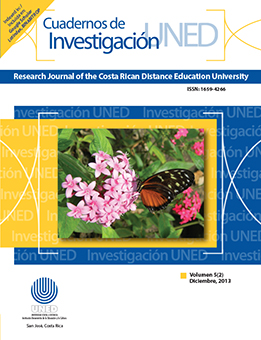Conservation of endemic species in the national system of protected areas from Nicaragua
DOI:
https://doi.org/10.22458/urj.v5i2.271Abstract
Nicaragua, in the framework of the Convention on Biological Diversity (CBD), agreed to establish a “Representative system of protected areas that adequately conserve biodiversity and terrestrial, marine and inland water ecosystems”. Pursuant to the above, we conducted a Gap Analysis of Biodiversity Conservation for the National System of Protected Areas (SINAP) of Nicaragua, focused on terrestrial and inland water ecosystems as well as on terrestrial species. This paper presents the results of the analysis of the conservation status of the endemic species in the national system of protected areas of Nicaragua. The groups considered for analysis were plants, mollusks, amphibians, reptiles, and mammals. Data presented came from reviewing books, scientific papers, management plans of protected areas and unpublished reports by the authors, and nearly 140 websites. Of the 75 plant species and 31 animal species considered in the analysis, 25 species have some distribution points within the SINAP (ten of them have only one point). There are 80 species apparently absent from the SINAP. Nicaraguan endemic species are severely unprotected.
KEY WORDS
Endemism, conservation, protected areas, Nicaragua, mollusks, amphibians, reptiles, birds, mammals, plants
References
Birdlife International. (2000). Threatened birds of the world. Barcelona and Cambridge, UK: Lynx editions and Birdlife International.
Brown, J.H., & Lomolino, M.V. (1998). Biogeografía. 2nd edition. Sunderland, Massachussets: Sinauer associates, inc.
CBD. (2004). Convention on Biological Diversity. Retrieved from http://www.biodiv.org/convention/partners-websites.asp.
Dudley, N., & Parrish, J. (2005). La creación de sistemas de áreas protegidas ecológicamente representativas. Mérida, Yucatán, México: The Nature Conservancy (TNC).
Grijalva, A. (1999). Diversidad de especies: flora. En: Biodiversidad en Nicaragua. Un estudio de país. Managua, Nicaragua: MARENA-PANIF.
Grooves, C., Valutis, L., Vosick, D., Neely, B., Wheaton, K. Touval, J., & Runnels, B. (2000). Diseño de una geografía de la esperanza: Manual para la planificación de la conservación eco regional. USA: The Nature Conservancy.
Köhler, G. (2002). A New Species of Salamander of the Genus Nototriton from Nicaragua (Amphibia: Caudata: Plethodondidae). Herpetologica, 58(2), 205-210
Köhler, G. (2003). Reptiles de Centroamérica. Offenbach, Alemania: Herpeton
Köhler, G., & Sunyer, J. (2006). A New species of Rain Frog (genus Craugastor) of the fitzingeri group from Rio san Juan southeastern Nicaragua. Senckenbergiana biologica, 86(2), 261-266.
Martínez-Sánchez, J.C. (2007). Lista patrón de las aves de Nicaragua. Managua, Nicaragua: ALAS.
MARENA. (2001). Estado de conservación de los ecosistemas de Nicaragua. En: Estrategia Nacional de Biodiversidad. Managua, Nicaragua: Imprimatur.
MARENA. (2011). Estudio de ecosistemas y biodiversidad de Nicaragua y su representatividad en el sistema nacional de áreas protegidas. Managua, Nicaragua: Embajada de Dinamarca.
Mayr, E., & Ashlock, P.D. (1993). Principles of systematic zoology. New York, USA: McGraw Hill.
Pérez, A.M. (2002). Malacogeographic regionalization, diversity and endemism in the Pacific of Nicaragua. Biogeographica, 78(3), 81-94.
Pérez, A.M. (2004). Aspectos conceptuales, análisis numérico, monitoreo y publicación de datos sobre biodiversidad. Managua, Nicaragua: Araucaria-Marena.
Pérez, A.M. (2008). Biodiversidad en Nicaragua. Contexto y estado actual. Encuentro, 79, 96-104.
Pérez, A.M. (2011). Análisis del estado de la biodiversidad y su conservación en Nicaragua y América Central. Gaia, 13, 65.
Pérez, A.M., & López, A. (2002). Atlas de los moluscos continentales del Pacífico de Nicaragua. Managua: Nicaragua: Editorial UCA.
Pérez, A.M., Siria, I., & Sotelo, M. (2005). Propuesta de Programa de investigación y monitoreo de la biodiversidad en áreas protegidas de Nicaragua. Informe final. MARENA-Proyecto Araucaria, Nicaragua.
Pérez, A.M., Zolototoff, J.M., & Siria, I. (2009). Evaluación de la biodiversidad del país. Informe de consultoría, Fundación Cocibolca. Managua, Nicaragua.
Stevens, W.D. (Ed.). (2001). Flora de Nicaragua. USA: Missouri Botanical Garden Press
Sunyer, J., Lotzkat, J.S., Herts, A., Wake, D., Alemán, B., Robleto, S., & Köhler, G. (2008). Two New species of salamanders (Genus Bolitoglossa) from Southern Nicaragua (Amphibia, Caudata, Plethodontidae). Senckenbergiana Biologica, 88(2), 319-328;
UNESCO. (1973). International mapping and classification of vegetation. UNESCO Ecology and Conservation Series 6.
Downloads
Published
How to Cite
Issue
Section
License
Note: This abstract contains an incorrect copyright due to technical issues. Authors who publish with this journal agree to the following terms: Authors retain copyright and grant the journal right of first publication with the work simultaneously licensed under a Creative Commons Attribution License that allows others to share the work with an acknowledgement of the work's authorship and initial publication in this journal
All journal contents are freely available through a CC BY 4.0 license.
CC BY 4.0 is a Creative Commons: you can copy, modify, distribute, and perform, even for commercial reasons, without asking permission, if you give appropriate credit.
Contents can be reproduced if the source and copyright are acknowledged according to the Open Access license CC BY 4.0. Self-storage in preprint servers and repositories is allowed for all versions. We encourage authors to publish raw data and data logs in public repositories and to include the links with all drafts so that reviewers and readers can consult them at any time.
The journal is financed by public funds via Universidad Estatal a Distancia and editorial independence and ethical compliance are guaranteed by the Board of Editors, UNED. We do not publish paid ads or receive funds from companies.




